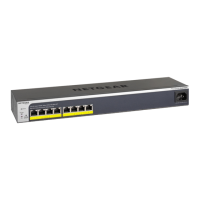Use VLANS for Traffic Segmentation
31
ProSAFE Easy-Mount 8-Port Gigabit Ethernet PoE+ Web Managed Switch
9. In the VLAN ID field, enter a VLAN ID.
You can enter a VLAN ID from 1 to 4094.
10. Click the Add button.
The new VLAN is added to the VLAN Identifier Setting table.
After you create a new VLAN ID, use the VLAN membership option to add ports to the
VLAN. (Select VLAN > 802.1Q > Advanced > VLAN Membership. See also Add
Tagged or Untagged Ports to an 802.1Q-Based VLAN on page 31.)
Note: To delete a VLAN, select the check box for the VLAN and click the
Delete button.
Add Tagged or Untagged Ports to an 802.1Q-Based VLAN
After you define a VLAN ID using the advanced 802.1Q VLAN option (see Create
802.1Q-Based VLANs in an Advanced Configuration on page 30), you must add ports to the
VLAN.
While you add ports to a VLAN, you can specify whether the ports must be tagged or
untagged. Port tagging allows a port to be associated with a particular VLAN and allows the
VLAN ID tag to be added to data packets that are sent through the port. The tag identifies the
VLAN that must receive the data.
By default, all ports are untagged.
To add tagged or untagged ports to an 802.1Q-based VLAN:
1. Connect your computer to the same network as the switch.
You can use a WiFi or wired network connection, or connect directly to a switch that is
off-network using an Ethernet cable.
2. Launch a web browser.
3. In the address field of your web browser, enter the IP address of the switch.
If you do not know the IP address of the switch, see Access the Switch Using a Web
Browser on page 6.

